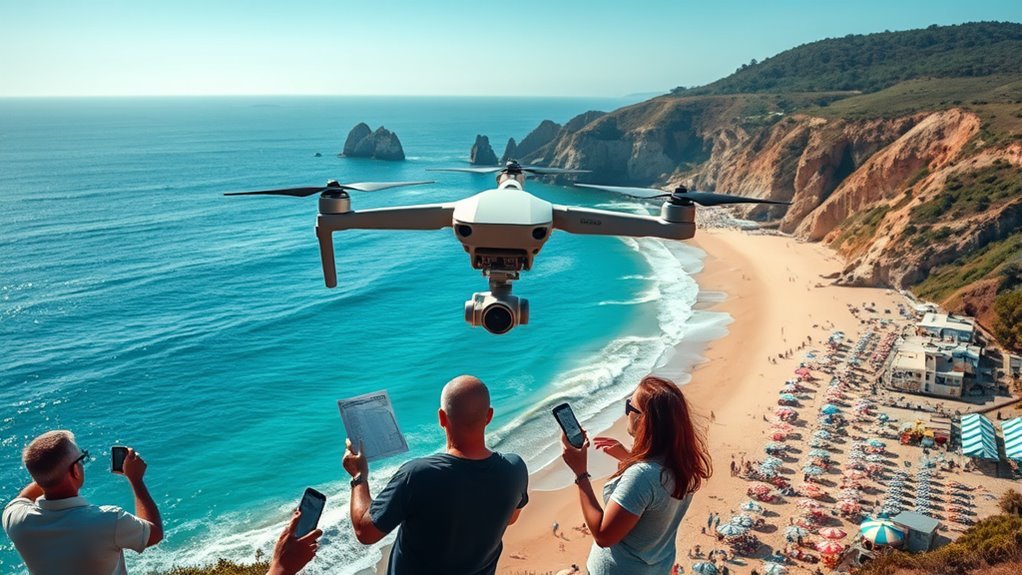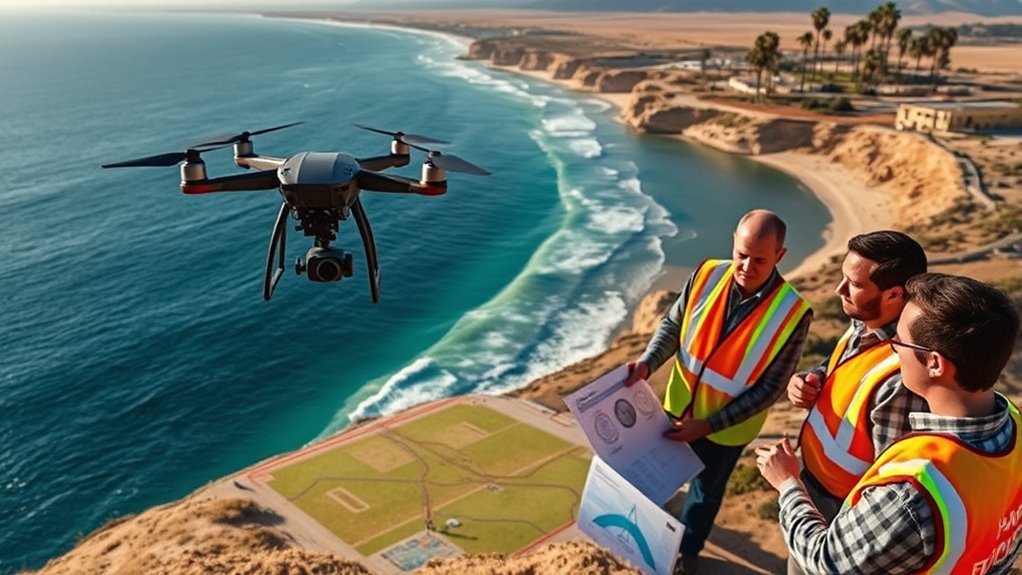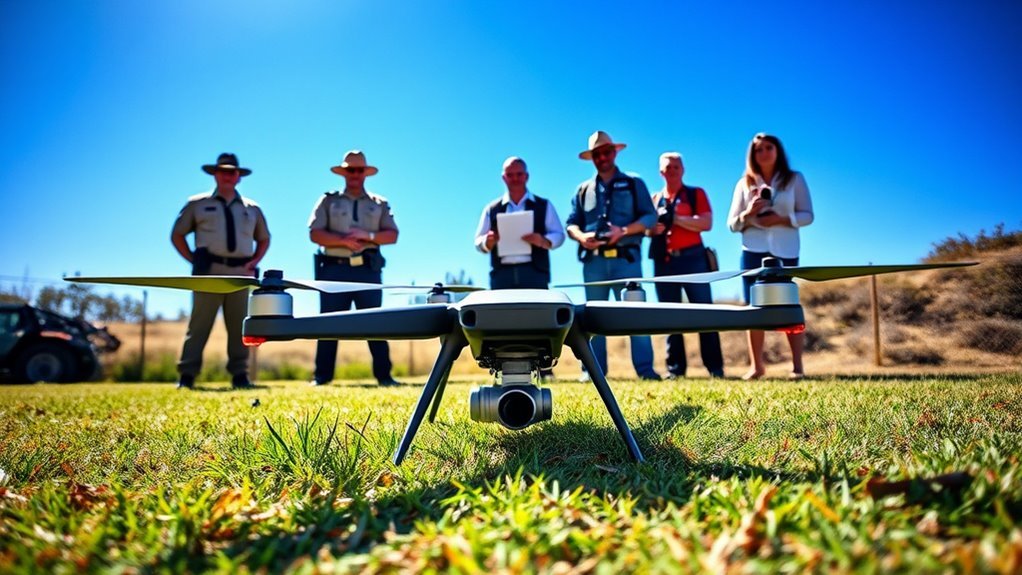To fly your drone in California, you should reach out to five key contacts. Start with the Federal Aviation Administration (FAA) for federal regulations. Next, contact the California Department of Transportation (Caltrans) to understand specific state policies. Local law enforcement can provide insight on community regulations. If you’re near national parks, the National Park Service is essential for compliance. Finally, always get permission from private property owners before flying overhead. There’s more to uncover about safe drone operations ahead.
Federal Aviation Administration (FAA)

When it comes to flying your drone in California, understanding the regulations set forth by the Federal Aviation Administration (FAA) is vital. These drone regulations dictate where and how you can operate your drone, guaranteeing safety and compliance. You’ll need to familiarize yourself with designated flight zones, which include restricted areas near airports and other sensitive locations. Additionally, you must adhere to altitude limits and maintain visual line-of-sight with your drone. By staying informed about these rules, you’ll not only secure your freedom to fly but also contribute to a safe environment for all airspace users. Ignoring these regulations can lead to penalties, so it’s important to be knowledgeable and responsible as a drone operator in California.
California Department of Transportation (Caltrans)

Understanding the role of the California Department of Transportation (Caltrans) is important for drone operators, as they oversee various aspects of transportation infrastructure that can impact your flying experience. Caltrans manages state highways and public roads, which means you need to be aware of specific drone regulations concerning these areas. If you’re planning to fly near or over state property, obtaining flight permits may be necessary to guarantee compliance. Additionally, Caltrans may have guidelines regarding drone operations near construction sites or maintenance activities. Staying informed about these regulations not only keeps you legally compliant but also enhances your ability to fly freely and safely in California’s diverse environments. Always check their resources for updates relevant to your drone activities.
Local Law Enforcement

Local law enforcement plays an essential role in regulating drone operations at the community level. They enforce drone regulations, ensuring that your flights are safe and lawful. Establishing a good rapport with local officers can help you navigate these rules more effectively. Consider reaching out to discuss your drone activities; they may appreciate community outreach and be more understanding of your intentions. Knowing the specific regulations in your area can prevent misunderstandings and potential fines. Engaging with law enforcement fosters a collaborative environment where you can express your desire for freedom in using your drone. Staying informed and involved in local discussions not only enhances your flying experience but also supports a culture of responsible drone use within your community.
National Park Service
Engaging with local law enforcement is just one aspect of traversing drone regulations in California; another important authority to evaluate is the National Park Service (NPS). If you’re considering flying your drone in a national park, you’ll need to familiarize yourself with specific regulations and obtain park permits. The NPS strictly prohibits drone use in most national parks to protect wildlife and preserve the natural landscape. However, exceptions exist, and you can apply for permits if your flight serves research or educational purposes. Understanding these rules is essential for maintaining the freedom to fly while respecting the unique environments within these parks. Always check the NPS website for the latest updates and guidelines before planning your flight.
Private Property Owners
When it comes to flying your drone, respecting the rights of private property owners is essential. Before you take off, verify you know who owns the land beneath your drone. Unauthorized flights over private property can lead to legal disputes and may infringe on property rights. It’s wise to seek permission from the owner, especially if you plan to capture images or videos. Additionally, consider obtaining drone insurance to protect yourself against potential claims. This not only safeguards your investment but also demonstrates your commitment to responsible flying. By respecting private property and getting the necessary permissions, you’ll foster a positive relationship with landowners, guaranteeing you can enjoy the freedom of flight without unnecessary conflicts.
Frequently Asked Questions
What Are the Height Restrictions for Flying Drones in California?
As you soar through the sky, drone safety’s your priority. In California, altitude regulations cap your flight at 400 feet in most areas. Stay informed, and cherish the freedom to explore the vast open skies responsibly.
Do I Need a License to Fly My Drone Recreationally?
You don’t need a license for recreational drone flying, but you must follow drone regulations overview and recreational flying guidelines. Understanding these rules guarantees you enjoy flying while maintaining safety and compliance with local laws.
Can I Fly My Drone at Night in California?
Flying your drone at night’s like dancing with shadows; you can, but must adhere to night flying regulations. Confirm your drone meets lighting requirements, illuminating your path while respecting safety and airspace rules.
Are There Specific Areas Where Drones Are Completely Banned?
Yes, there are specific areas where drones are completely banned. These include drone no fly zones like airports and military bases, along with restricted airspace, which you must avoid to guarantee safe and lawful flying.
How Do I Report a Drone Incident or Violation?
In 2022, over 1,400 drone incidents were reported, highlighting the importance of drone safety. To report a violation, document the incident thoroughly and contact local authorities or the FAA for incident reporting guidance.

